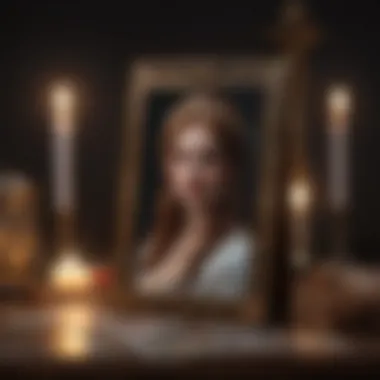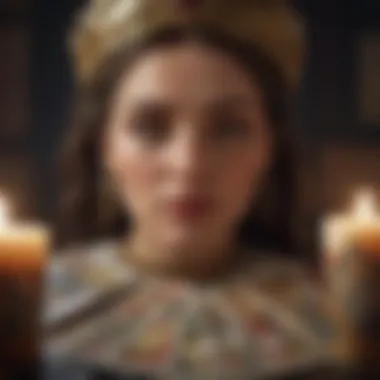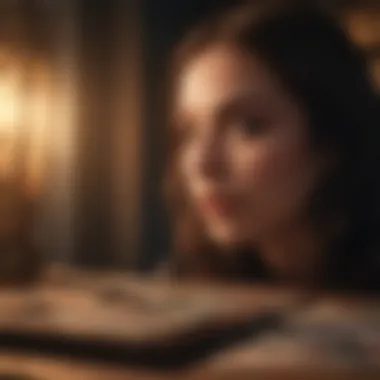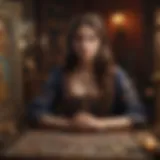Understanding His Feelings Through Tarot Readings


Intro
The intricate dance between love and emotions often remains elusive, particularly when it comes to understanding a partner's true feelings. Within the esoteric world of tarot, there lies a methodology that pierces the veil. This exploration of tarot as a tool for emotional insight aims to engage readers, particularly those initiated into the arts of tarot and astrology. It is vital to approach tarot with sincere intention and a willingness to uncover sometimes uncomfortable truths. With the right methodology, tarot can open doors to understanding the complex emotional landscape of relationships.
Characteristics of Each Zodiac Sign
Understanding zodiac characteristics can greatly enhance tarot readings and intuitions. Each zodiac sign reflects particular personality traits that can influence a person’s feelings and approach to relationships. Here is an overview of the zodiac signs, noting their distinct strengths, weaknesses, and interpersonal compatibilities.
Overview of personality traits
- Aries: Confident, enthusiastic, often impulsive.
- Taurus: Practical, reliable, can be stubborn.
- Gemini: Adaptable, communicative, yet indecisive.
- Cancer: Nurturing, emotional, sometimes overly sensitive.
- Leo: Charismatic, warm-hearted, needs validation.
- Virgo: Analytic, detail-oriented, modest.
- Libra: Diplomatic, social, struggles with decisions.
- Scorpio: Intense, passionate, can be secretive.
- Sagittarius: Optimistic, adventurous, may lack tact.
- Capricorn: Disciplined, responsible, potential to be cold.
- Aquarius: Innovative, independent, often detached.
- Pisces: Intuitive, compassionate, can be escapist.
Strengths and weaknesses
Every zodiac sign exhibits strengths and weaknesses that enter into relationships. Understanding these can help tarot readers interpret cards regarding emotions efficiently. A compassionate Scorpio can easily misunderstood their intensity, while a playful Gemini may undermine their stability in a relationship due to indecisiveness.
Compatibility with other signs
While individual signs have unique traits, compatibility among different signs offers insight into emotional relationships. For example:
- Aries often pairs well with Leo or Sagittarius but can struggle with Cancer or Capricorn.
- Taurus feels grounded with Virgo and Capricorn, yet may clash with more free-spirited individuals like Aquarius.
Daily, Weekly, Monthly Horoscopes
By referring to detailed horoscopes, individuals can anticipate specific fluctuations in their emotional environments. Taking it into account can reset interpersonal dynamics. Daily, weekly, or monthly readings can emphasize areas to focus on, aiding understanding in relationships.
Love and Relationships Horoscopes
Horoscopes focusing on love and relationships can guide individuals through complex emotional networks. They provide insights into tendencies, allowing for preparatory approaches to potential problems. Readings can indicate when to engage in difficult conversations or when patience might yield better results.
How to Interpret Tarot Cards
A standard understanding of tarot involves differences between Major and Minor Arcana. Each conveys unique messages. Understanding the influence of key cards significantly enhances one’s reading capabilities. Furthermore, also knowing renowned decks like the Rider-Waite can create a firm foundation for interpretation.
Major and Minor Arcana
- Major Arcana: Represents major life themes and significant emotional phases.
- Minor Arcana: Illuminates daily events and situations occurring within the subconscious.
Meaning of key cards
Commonly appearing cards like The Lovers, Three of Swords, or The Moon come with specific emotional nuances. Learning each will help pinpoint feelings tied to tarot readings focused on relationships.
Sample interpretations in different spreads
Utilizing various tarot spreads can represent the querent's romance with more profound depth. A simple past-present-future spread can dip into a partner's emotions as they develop over time.
Overview of deck styles
Many deck styles exist, from traditional Western to more culturally based decks that incorporate unique symbolism, such as the Thoth Tarot or the Wild Unknown Tarot.
Popular decks and thier unique features
A reader acquainted with multiple decks can choose one based on the queried individual and circumstance, influencing interpretations richly.
Understanding Birth Charts
Birth charts form a vital part of astrological understanding. By examining core components like Zodiac sign positions, aspects, and ruling houses, a tarot reader gains much more emotional insight about the subject.
Astrological Events and Celestial Occurrences
Being aware of key astrological dates can give periods of enhanced emotional awareness, whether due to retrograde influences or significant eclipses.
Beginners Guide to Astrology
For those unfamiliar with astrology, a basic comprehension can empower tarot readings. Insights from horoscopes offer a means of personal growth when interpreted adequately. Understanding captures both revealing one’s strengths and highlighting potential areas for improvement in relationships through tarot insights.
“Combining tarot with astrological knowledge broadens the lens through which we view relationships, helping to unlock emotional depths previously trudged beneath the surface.”
The Role of Tarot in Modern Relationships
In today's world, tarot serves a multifaceted role in modern relationships, acting as both a tool and a lens through which partners can explore their emotions. It provides an avenue for introspection and understanding, especially when navigating complexities of romantic dynamics. Many people seek insights from tarot to clarify their thoughts and feelings about their partners. This can lead to deeper connections and awareness within a relationship.


Moreover, bat employs of this ancient practice can highlight developing emotional patterns. By analyzing tarot readings, individuals often discover hidden sentiments or unspoken issues. This understanding can foster healthier communication and emotional growth within the partnership. Tarot allows individuals to confront difficult feelings without direct confrontation. It is this indirect approach that often makes tarot appealing to those hesitant about discussing deep-rooted emotional issues.
In practical terms, tarot serves several benefits within relationships, including:
- Enhanced Communication: Readings often open pathways for candid discussions between partners.
- Self-Discovery: Individuals may gain insights into their own feelings and biases, improving overall emotional intelligence.
- Navigating Conflict: Tarot cards can suggest ways to approach disagreements or differing values between partners.
- Reinforcing Bonds: Shared tarot experiences can create a sense of unity and embark on mutual growth.
Fat there are also vital considerations. It is crucial to approach readings with clarity of intention to ensure sincere interpretations. Misunderstandings can arise from ambiguous questions or unclear thoughts. Thus, preparation is key to engaging effectively with tarot.
"Tarot's wisdom lies not only in its divination but through its ability to shine a light on one's own heart and mind."
Overall, tarot plays a significant role in fostering connections and enhancing emotional literacy. Taking time to interpret the imagery and meanings can lead each partner closer to understanding not only themselves but also each other. As relationships evolve, the insights gained through tarot often mirror the growth experienced personally and as a couple.
Historical Context of Tarot in Love Readings
To appreciate the influence of tarot on modern relationships, one must consider its rich historical context. Tarot cards, believed to have originated in the 15th century in Europe, have long been associated with divination and mystical practices. They initially appeared as playing cards before evolving into tools used for enlightenment and reflection.
In the 18th century, tarot became particularly associated with spiritual and esoteric studies. Scholars started linking tarot to Kabbalah and the Hero's Journey. This connection laid the groundwork for using tarot in matters of love. Over the decades, the allure of love readings evolved, making tarot cards significant in romantic contexts. Those seeking guidance in their relationships often turned to tarot due to its combined visual symbolism and rich interpretations, boosting its popularity.
Likewise, renowned figures in the early 20th century contributed to tarot's rise in current practices. Described as a means of obtaining personal insight, historians like A.E. Waite crafted tarot systems and established meanings that are still in use to date. Their respective viewpoints enabled further exploration of tarot in relationships.
Consequently, today's use of tarot in love readings carries benefits, from answering pivotal questions about compatibility to providing closure in complex relationship situations. With each card liberating its unique predictions, tarot enables users to reflect deeply upon their emotional journeys, encouraging conscious exploration of what lays beneath.
How Tarot Differs from Conventional Relationship Advice
Tarot stands apart from standard run-of-the-mill relationship advice in various notable ways. First, tarot readings possess a more personalized touch, tailoring guidance to individuals' specific contexts. Unlike generic advice columns, cards reflect a unique source of self-discovery for assessing one's feelings. In this, tarot can reveal possibilities and lead users to unexpected conclusions.
Second, tarot accounts for emotional nuances. Conventional advice often directs individuals with prescriptive statements that can oversimplify complexities surrounding relationships. Tarot, conversely, presents diverse interpretations, often addressing the most intricate dynamics like jealousy, insecurity, and emotional misalignment. Prioritizing raw feelings also helps tarot lead users toward internal resolutions.
Moreover, the involvement of intuition in tarot adds another layer of depth. While established advice typically relies on universal principles gleaned from research or experience, tarot uses an instinctive approach guided by one’s circumstances. This renders the outcomes of readings highly relevant.
In essence, tarot functions as an interactive process. Users may gradually unveil elements affecting their emotional wellbeing as they interact with the cards drawn for them. Therefore, for those looking to understand subtle shifts in their partner’s feelings, tarot often proves a more enlightening choice. Having alternative perspectives from tarot readings clarifies obscure emotional terrains that standardized relationship guidance may miss.
Interpreting His Emotions: Key Tarot Cards to Consider
Understanding how to interpret his feelings through Tarot involves recognizing the significance of specific cards that frequently appear in love readings. Each card contributes uniquely to the emotional narrative of the relationship.
By gaining insight into particular key Tarot cards, one can unveil underlying emotions, desires, and intentions. This exploration not only fosters connections but also provides clarity in navigating complex emotional landscapes.
The Lovers Card: Significance in Romantic Contexts
The Lovers card holds profound implications in Tarot, particularly concerning love and relationships. At its core, this card suggests choice, harmony, and the interrelationship between partners. It emphasizes unity, often representing a deep emotional or spiritual bond. When this card appears in a reading, it may indicate an optimal phase where both individuals are aligned, expressing mutual admiration and affection.
Challenges may accompany the depiction of The Lovers card as well. It encourages individuals to carefully consider choices affecting their bond. The Lovers can illuminate essential conversations about commitment and intimacy. By pushing for openness, partners may understand each other’s beliefs and emotional stakes better.
The Two of Cups: Mutual Feelings and Connections
The Two of Cups symbolizes reciprocal feelings and partnerships. This card conveys the essence of empathy and emotional exchange, highlighting the strength of partnership based on trust and mutual respect. The presence of The Two of Cups signifies moments when both partners are attuned to each other's feelings, establishing a foundation where relationship growth can happen.
To interpret this card effectively, one should focus on how each partner views the partnership. Recurrent appearances of this card warrant reflection on how both individuals can engage more valuably. The Two of Cups serves as a reminder to deepen communication and emotional vulnerability, allowing the relationship to flourish.
The Knight of Cups: Romantic Intentions and Idealism
The Knight of Cups presents a nuanced view of love. Often characterized by dreamy idealism, this card tends to portray an individual who is romantic and emotionally driven. When examining the Knight, consider his approach toward others in the context of emotional expression. This card can reveal someone yearning for connection through artistic expression or grand romantic gestures.
However, idealistic tendencies may result in unrealistic expectations within a relationship. Inverting interpretations might draw attention to unfulfilled expectations, causing frustration. Highlighting these emotional inclinations is crucial, as it allows partners to reassess their ideals versus reality, fostering more conscious interactions.
"To truly understand emotional dynamics, one must recognize both the uplifting desires and potential downfalls within the cards."
In summary, exploring these Tarot cards provides a versatile framework for understanding a partner's emotions. With deeper consideration and interpretation of these key symbols, individuals can enhance empathy and trust in their relationships. Properly understanding emotional reflections results not just in harmony but a path to continued exploration of love's complexities.
Psychological Aspects of Tarot Readings
The realm of tarot readings is intertwined with numerous psychological factors that seamlessly influence interpretation and the understanding of emotional dynamics. Recognizing these psychological aspects is crucial for utilizing tarot effectively, particularly for those aiming to decipher a partner's feelings. Tarot operates not only as a tool for divination but also as a mirror reflecting our inner workings. Understanding these concepts can enhance the reading experience, providing richer insights into the emotional landscapes that shape relationships.
Among the most vital psychological elements are cognitive biases and intuition. These aspects influence how we interpret the messages of tarot cards, allowing us to navigate through underlying emotions that define romantic connections. Both cognitive processes and a trusting of one's instincts contribute to a more meaningful engagement with tarot that can illuminate relationship nuances.
Cognitive Bias and Interpretation of Tarot Cards
Cognitive bias plays a significant role in how tarot readings are conducted and interpreted. This refers to the systematic patterns of deviation from norm or rationality in judgment. People have expectations, sometimes shaped by previous experiences, beliefs, and emotions, impacting the interpretations of cards in a reading.
For instance, confirmation bias can lead a reader to seek out information that aligns with their initial beliefs, potentially distorting the message of the cards. If someone has a preconceived notion about their partner, they may unconsciously focus on cards that reinforce those ideas rather than exploring the full context. This situation could create a narrow view rather than a holistic understanding of feelings.
To mitigate the impact of cognitive bias, it's essential to approach readings with an open mind. Keeping a journal before pulling cards can aid clarity. Writing down initial feelings and specific questions can provide a reference point that invites exploration beyond existing assumptions.


The Power of Intuition in Tarot Readings
Intuition is a powerful element in the practice of tarot. It can allow the reader to connect deeply and meaningfully with the cards and their energy. Unlike cognitive interpretations, intuition relies on subconscious understanding that arises in response to the imagery and symbolism of the tarot.
In each tarot card lies a myriad of meanings, some often overlooked by logic or analysis. By tuning into intuitive thoughts and feelings, a tarot reader can tap into a deeper understanding of relationship dynamics. This process often leads to surroundings insights, rather than strict factual conclusions drawn from analytical reasoning.
Moreover, incorporating mindfulness practices can enhance intuitive capacity during readings. Taking a moment to breathe and centre oneself can foster clarity. Readers who cultivate a practice of intuitive awareness often find their interpretations become more nuanced and directed.
"Tarot cards act as conduits; shedding light on not only events but the emotional fabric that connects two individuals.
Setting Intentions for Your Tarot Reading
Setting intentions is a fundamental step when engaging in tarot readings, especially when the aim is to understand someone's feelings. This process involves clarifying what you hope to achieve and furnishing context to the reading. By establishing a specific focus, you can facilitate a deeper connection to the cards and their meanings. Failing to set clear intentions can lead to ambiguity during a reading. This can affect the clarity of insights gained. Therefore, it's essential to approach each session with a strong sense of purpose.
The Importance of Clarity on Questions and Intent
One cannot overstate the significance of clarity in both questions and intentions when conducting a tarot reading. When your question is vague, the responses you receive may also be unclear or irrelevant. To be effective, it is crucial to come with questions that have depth and specificity. For example, rather than just asking, 'What about my relationship?', consider rephrasing it to something like, 'What does he feel about the current state of our relationship?'. This framing provides the reader with substantive context and paves the way for more meaningful interpretations based on the drawn cards.
In addition, when clarity is achieved, it becomes easier to relate the card meanings back to the query. This practice strengthens the relationship between your intention and the outcomes of your reading. It helps in pinning down emotional themes that could be beneficial in understanding a partner’s feelings better.
Creating a Conducive Environment for Accurate Readings
Creating a favorable environment for a tarot reading impacts the quality and accuracy of the insights. Begin by ensuring that you have a quiet, private space where interruptions are minimal. This setting allows for deeper reflection and enhances your emotional receptivity.
Consider some specific factors when setting up your space:
- Lighting: Use soft, ambient lighting to foster a calm atmosphere.
- De-clutter: Remove any distractions that may divert your focus away from the reading.
- Enhancements: Incorporating elements like crystals, incense, or meaningful objects can amplify your connection to intuition and the tarot cards.
Additionally, considering your own mental and emotional state is equally important. Centering yourself through mindfulness exercises can indeed prepare your mind for the reading. Take deep breaths and give yourself a moment of stillness before beginning. It puts you in a better place to interpret the cards comprehensively, reducing anxiety or chaotic thoughts.
The clearer your questions and intentions, the more tailored insights your tarot reading will offer, ultimately enhancing your understanding of emotional dynamics.
By establishing a purposeful framework for your readings and nurturing an environment that supports your mental clarity, the potential for richer revelations and emotional comprehension through tarot increases multifold.
Deciphering the Reading: Practical Techniques
Deciphring a tarot reading is both an art and a science. Understanding how to approach a reading can provide invaluable insights for anyone seeking to understand a partner's feelings. This section will cover two critical techniques: recognizing reversed cards, and understanding the significance of card positions within a spread.
Understanding Reversed Cards and Their Implications
Reversed cards often invoke a blend of confusion and intrigue. Many who turn to tarot aren't sure what these overturned energies represent. A reversed card signifies a shift or block in the usual interpretations associated with that card. For instance, if the Lovers card appears reversed, it could indicate discord in a relationship rather than harmony. This realization is crucial; it empowers you to delve deeper into the emotional complexities at play.
It's essential to approach reversed cards with an open mindset. Their implications can vary widely based on surrounding cards and individual querent situations. Some common perceptions include:
- Inner Reflection: Reversal may point to introspective issues rather than external conflicts.
- Blocked Energy: Reversed cards can imply stagnant situations like unresolved issues or past betrayals.
- A Call for Change: An inversion often indicates a need for change. This can drive meaningful conversations about where things stand.
Utilizing reversed cards means considering context. This will offer critical understanding to his feelings and intentions without missing heavy underlying contexts.
Contextualizing Card Positions in a Spread
Each card in a spread has a designated role that adds flavor to the reading. Context is invaluable when deciphering ongoing emotional dynamics. Card positions help dictate what aspect of the situation the tarot is illuminating, leading to more refined insights into his emotional landscape.
For example:
- Present Position: Indicates current emotions or life circumstances.
- Past Influences: Highlights how previous experiences shape current feelings.
- Future Implications: Offers prediction tendencies or potential outcomes.
Analyzing card positions can be done utilizing frameworks like the Celtic Cross or three-card spread, each providing its own context for interpretation. The key is to amalgamate meaning across all cards seen on the table.
Engaging with the interplay among cards can enhance comprehension of his emotions. Not only can it strengthen emotional awareness, it fosters communication, allowing both parties to discuss perspectives aligned with insights drawn from the reading.
The combination of understanding reversed cards and contextualizing card positions offers a sturdy foundation to navigate his emotional response through tarot.
Navigating His Emotional Landscape Post-Reading
Understanding his emotional landscape after a tarot reading is vital. The reading can unveil hidden feelings, desires, and stalemates that may exist in your relationship. By grasping these insights, you create a pathway to facilitate clearer communication and empathic understanding. While tarot does not provid direct answers, it encourages a journey of self-discovery and introspection. Here, we explore how to practically address insights from tarot readings and also leverage them for building emotional intelligence.
How to Address Insights Gained from the Reading
After the tarot reading, consider the following steps to help address insights you have recevied:
- Reflect Individual Feelings: First, reflect on how you feel about the insights gained. What emotions arise in you? Understanding your response is key to processing the information in a healthy way.
- Communicate Openly: Engage in coverstation with your partner. Share what you learned and how their actions align (or do not align) with the insights. Effective communication is central to integrity in the relationship.
- Avoid Assumptions: Insights from the tarot should not dictate your view on your partner's emotions. Human emotions are complex. It might be beneficial to avoid judgment or assumptions based on single cards or readings.
- Constructive Actions: Use insights to guide your daily interactions. For example, if any issue in the relationship arises, relate it back to insights gained from the reading, analysing whether patterns shown in the cards match current behaviour.
When reading tarot, always keep in mind that cards are suggestive tools meant to enlighten your perceptions rather than dictate actions.


Building Emotional Intelligence Through Tarot Insights
Emotional intelligence entails recognizing, understanding, and managing emotions in yourself and others. Tarot readings can cultivate a rich ground for building this skill:
- Promote Self-Awareness: Tarot often reflects personal emotional states and realities. Look into what emotions the cards evoke in you and why. This self-awareness is the bedrock of emotional intelligence.
- Enhance Empathy: Use the reading as a lens to reconsider your partner's perspectives. What cards indicate their emotional state? Engage empathetically, allowing emotional currents to flow between you.
- Resilience Through Reflection: Building emotional intelligence through tarot encourages you to explore both positive and negative emotions fortovoltaic. Remember, some insights might highlight issues or rifts; approach them with an open mind to transform uncomfortable topics into growth opportunities.
- Practice Mindful Responses: When discussing findings from tarot, foster a mindful approach. Instead of reacting straight away, take a moment to breathe, reflect, and visualize ways each card's narrative fits into the ongoing relational story.
Building emotional intelligence isn’t a quick fix; it's a gradual process. Tarot serves as a helpful tool to navigate this journey, enabling deeper connections and healthier communication.
“Emotional intelligence is not the end goal, but a means to better relationships and compassion towards oneself and others.”
The Ethics of Tarot Readings in Relationships
The ethics surrounding tarot readings in romantic contexts are of utmost importance. When practitioners engage in tarot readings concerning relationships, the sensitivity of emotions and personal situations increases. Understanding these ethical considerations can contribute to more profound relationships and mutual respect.### Core Ethical Considerations:
- Emotional sensitivity is crucial in these readings. Tarot does not just predict possible futures; it probes into the internal world of individuals. The reader must navigate these insights without overstepping emotional boundaries.
- Integrity and honesty become paramount when interpreting cards. It is essential to provide interpretations that truly reflect the complexities of the situation, instead of gives overly simplistic answers.
- Confidentiality is a must. Any shared information during a reading must remain private. This respect underpins trust and ensures that the individual seeking insights feels safe.
Ethical conduct in tarot readings fosters trust and deepens mutual respect among partners, allowing emotional journeys to flow more smoothly.
Respecting Privacy and Emotional Boundaries
Respecting the privacy of both parties in a relationship is a fundamental aspect of responsible tarot practice. Boundaries can mitigate emotional distress and miscommunication. When readings fit this framework, they help individuals navigate their feelings night,.
Considerations for respecting emotional boundaries include:
- Being aware of the other person's emotional state during the reading. If they express discomfort or hesitation, the reader ought to pivot the discussion away from sensitive topics.
- Avoiding unnecessary probing into someone else’s private life without explicit consent. Delving too deep can create mistrust and anxiety.
- It is helpful to establish whether the person being read desires input from their partner as well.
This awareness underlies respectful communication, deepening the understanding of relationships.
Navigating Consent in Tarot Practice
Consent serves as the foundation of ethical tarot readings. This principle extends beyond mere oral agreement; it includes ongoing dialogues about what individuals expect from readings. Practitioners should help bolster healthy interactions by fostering clear discussions.
Key considerations when navigating consent:
- Prior to a reading, it is beneficial to explicitly inquire whether consent to discuss a partner's feelings is present.
- Continuous checking for agreement is vital. Ensure both parties feel uneasy about specific topics or feel free to demand a pause.
- Displaying respect for opinions during card interpretations promotes a feeling of inclusion, making both individuals feel heard.
Understanding and respecting consent not only solves ethical dilemmas but also enriches the dynamic between partners while they engage with the insights provided.
Beyond Tarot: Other Tools for Understanding His Feelings
Understanding feelings in relationships is complex. Tarot offers unique insights; still, it is essential to acknowledge other methods. Tools beyond tarot can complement the readings by providing a fuller emotional picture.
Using various avenues like astrology and psychological assessments enriches overall understanding. Each tool has strengths, helping to interpret feelings of partners accurately. This layered approach can offer clarity while avoiding overreliance on any one method. A balanced perspective encourages more nuanced interpretations of emotional dynamics, enhancing communication and connection.
Astrology and Relationship Compatibility
Astrology serves as a fascinating lens to examine compatibility in relationships. By analyzing astrological charts, you can glean essential traits influenced by zodiac signs. Each sign comes with particular attributes which, when understood systematically, can shine light on relational dynamics.
- Sun signs provide insights into core personalities
- Moon signs reveal emotional responses
- Rising signs show outward demeanor
Astrological compatibility goes beyond mere sun signs. Synastry, the study of how different charts interact, can indicate potential challenges and harmonies. Combining this knowledge with tarot interpretations, such as the Lovers card, can provide cohesive insights into feelings.
For instance, when two people share a mutable sign trait, flexibility in expressing emotions might be apparent when drawing the Knight of Cups. Higher compatibility tends to correlate inversely with stress levels in partnerships. Members interested in this extensive study can check resources like Wikipedia.
Psychological Assessments and Evaluations
Psychological evaluations offer another layer for derstanding feelings. Tools like the Myers-Briggs Type Indicator or the Enneagram assist individuals in determining personality profiles. Knowing how personalities mesh can enhance relationship dynamics as fundamentally, emotional responses come from personality dispositions.
While interactions through tarot often reveal desires and trains, psychological evaluations reveal governing patterns. Patterns encourage deeper questions, necessary for emotional growth. Understanding your partner's attachment style, for instance, gives immense insight into their behavior and reactions. Observing how one might respond under stress can open the door to comprehending frustrations or emotional withdrawal. This knowledge falls in line with interpreting setbacks hinted at in tarot readings. Therefore, merging such assessments with tarot techniques fuels nuanced examination of feelings in a relationship.
As you explore these alternatives, they can bring additional depth to your learning. Both astrology and psychology have rich histories, much like tarot. Adopting multiple tools ensures a well-rounded grasp of emotions and how they play out in relationships.
The End: Fostering Deeper Connections with Tarot
In the realm of emotional understanding, tarot serves as a multifaceted tool for couples seeking deeper connections. This article has explored various dimensions of how tarot can illuminate a partner's feelings and facilitate more meaningful discussions about emotions. By utilizing tarot readings, individuals can reflect on their relationship dynamics while also acknowledging their personal growth. Such insights not only foster understanding but also propel relationships toward long-term empathy and care.
The Ongoing Journey of Understanding Emotions
Understanding emotions is not a single event; it is an ongoing journey. Each tarot reading can uniquely resonate with life's complexities and challenges in a relationship. It's important to remember that no one tarot card holds absolute power. Instead, the various cards and their positions in the spread create a dialogue that articulates emotional nuances. This dialogue evolves with time, much like relationships themselves.
Individuals are encouraged to revisit their interpretations periodically. What may appear clear in one reading might shift drastically in a different context. By committing to this evolving process, partners learn to navigate deeper emotional waters—recognizing feelings that were previously unnoticed.
"The journey to understanding emotions is multifaceted, layered in nuances that shape our interactions and strengthen bonds."
Encouragement for Continued Exploration
Fostering a connection through tarot reading invites couples to dig within. Not only does this nurture empathy but also ingrains accountability in emotional matters. Here are several approaches to continue this exploration:
- Set regular check-ins to empathy map feelings, useful after each tarot session.
- Maintain a shared journal detailing insights from readings for reflections later.
- Weekly partner readings can catalyze necessary discussions about everyday emotions and issues.
- Explore other esoteric tools, like astrology, that complement tarot and broaden emotional insights.







